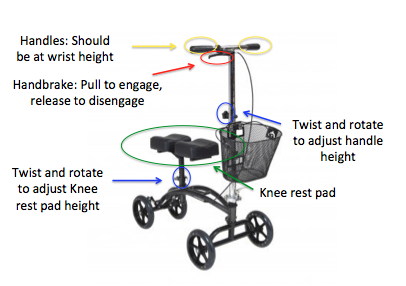Background
A knee walker or also known as a knee scooter, is a medical assistive device consisting of a metal frame and a pad to rest a person's knee. The user of the knee walker will hold onto the handle bars and rest the injured leg on the rest pad. Then, they will use their non-injured leg to move forward just like using a scooter. Knee walkers have several points of contact which consist of wheels. Common uses for knee walkers are people with recovering from surgery and/or people who have non-weight bearing status for a lower extremity due to an accident. Also, a knee walker may be suggested if the person is not comfortable using crutches.
Fitting
Knee Walker Height: Adjust the knee walker height by twisting the knob below the handles. Ideally the handles should come up to a patient's wrist when standing erect. When using the knee walker, the patient should display a slight bend in the arms.
Knee Rest Pad Height: The knee rest pad height should come to the bottom of the person's knee while in standing.

Buy on Amazon
Video
Safety
Before using the knee walker it is important to make sure:
- The knee walker is correctly fitted
- All buttons are are engaged fully and are not pressed in
- The wheels of the knee walker are not completely worn at the bottom
- The handles are attached sturdily and do not move when pressure is applied through them
- No components are loose
- Inspect the knee walker and parts for dents, cracks, or any irregularities
- DO NOT USE THE KNEE WALKER ON THE STAIRS
Stairs
It is NOT recommended to use a knee walker for ascending or descending stairs due to safety concerns.
